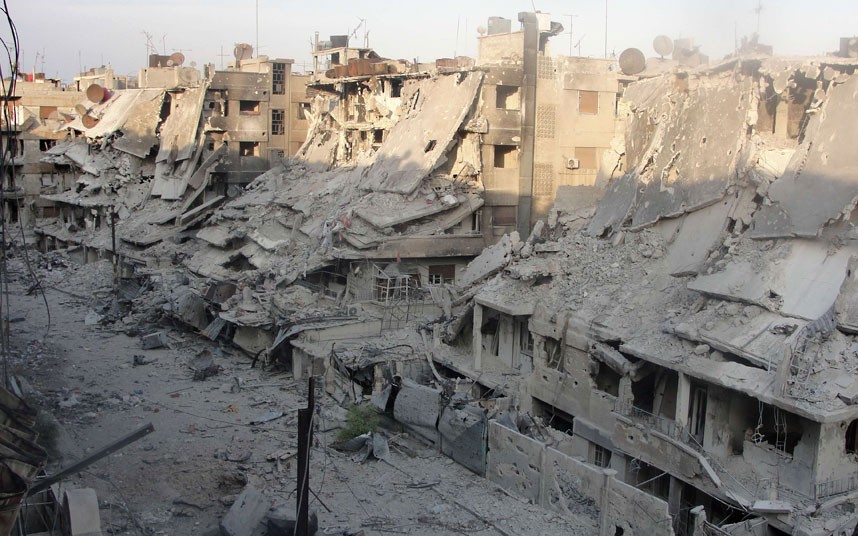
By RYAN LUCAS
It began in March 2011 with a few words spray-painted on a schoolyard wall: “Your turn is coming, doctor.” The doctor in question was Syrian President Bashar Assad, a trained ophthalmologist whose family has ruled the country for more than 40 years.
Inspired by uprisings rippling across the Arab world, Syrians flooded the streets for largely peaceful demonstrations demanding change and political reforms. The security services greeted them with clubs, bludgeons and bullets. The protests persisted in the face of an escalating government crackdown before the opposition eventually took up arms, slowly turning the uprising into a voracious civil war that continues to devour the country and drag the region into its maelstrom.
Four years on, there is no end in sight. As Syria marks the fourth anniversary of the uprising, here’s a look at the conflict, its enormous price and how we got here:
WHAT HAS BEEN THE CIVIL WAR’S TOLL?
Staggering, by any measure. More than 220,000 people have been killed and an estimated 1 million wounded in a country with a pre-war population of 23 million.
Nearly 4 million people have fled Syria, putting a massive burden on the countries taking them in — q. Another 7.8 million people are displaced within Syria, part of an estimated 12.8 million who are in dire need of humanitarian assistance. Diseases eradicated years ago, such as polio, have staged a comeback as the health care system has collapsed.
Bridges, roads, power plants, schools, hospitals, entire neighborhoods and even towns have been destroyed. Aleppo, once the country’s largest city and its commercial capital, has been split apart and devastated by rebels and government forces.
Syria’s social fabric is equally in tatters. The country is home to a tapestry of faiths and ethnicities — Sunni and Shiite Muslims, Alawites, Druze, Kurds and Christians. Before the war, the various communities by and large co-existed peacefully and even intermarried.
But the longer the war has gone on, the more sectarian it has become. All sides have committed atrocities, but the scale of the government’s misdeeds is exponentially greater than the opposition’s. The Sunni-dominated rebellion is trying to topple a government deeply associated with Assad’s Alawite sect, an offshoot of Shiite Islam. The president’s heavy reliance on regional Shiite power Iran and the Lebanese militant Hezbollah group has further fueled sectarian animosities.
IS IT STILL ABOUT ASSAD?
It depends on who you ask. For the armed opposition, Assad remains the murderous dictator whose ouster has always been and remains the overriding goal. That fight, however, has been largely overshadowed by the rise of the Islamic State group, which has seized control of around a third of both Syria and Iraq and declared its own self-styled caliphate. The United States and its Arab and Western allies have been conducting airstrikes against the extremists since August, although the primary concern for the Obama administration remains Iraq, not Syria.
Washington still publicly hews to the line that Assad must go, but the White House has done little to help usher him out the door. It has repeatedly balked at boosting support for the mainstream armed opposition, and a new program in the works aims to train a small number of rebels to fight the Islamic State group, not Assad.
HOW IS ASSAD STILL IN POWER?
The Syrian leader’s grip on power looked shaky in 2012, prompting predictions that his fall was imminent. But Assad, his inner circle and security establishment proven remarkably resilient. They managed to shore up their hold on Damascus and the urban centers in the heavily populated western half of the country.
Support from Iran, a close ally, has proven instrumental in steadying Assad. On the military front, Tehran has provided advisers and billions of dollars in aid. It has helped train tens of thousands of Syrian paramilitary fighters known as the National Defense Forces, which fight on front lines across the country. Tehran’s greatest contribution may be roping in Shiite militias from across the region — particularly Lebanon’s Hezbollah but also fighters from Iraq —to reinforce the government’s beleaguered troops.
WHAT DOES THE FUTURE HOLD?
Nothing points to the conflict ending anytime soon. The government and the opposition view the war as an existential struggle and have yet to bleed themselves out. The Islamic State group is focusing its efforts on building its self-declared caliphate and wages war against anyone that stands in its way — Assad, rebels, Kurds.
Every diplomatic effort so far has failed. Peace talks between the opposition and the government last year broke down after two rounds and zero progress. A Russian initiative this year to bring the two sides to the negotiating table in Moscow fizzled quickly after the main opposition figures boycotted.
The current U.N. envoy to Syria, Staffan de Mistura, has set himself the more modest goal of trying to “freeze” the fighting in Aleppo, which he envisions as a first step toward a wider easing of hostilities. But even this plan faces considerable obstacles and has been greeted with skepticism. The government has agreed to halt airstrikes and shelling in Aleppo for six weeks. De Mistura is still working to secure the support of the multitude of armed opposition groups in the city, many of which distrust the envoy and the government and want a comprehensive solution.
My Way/AP

Leave a Reply
You must be logged in to post a comment.